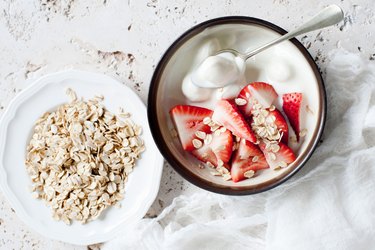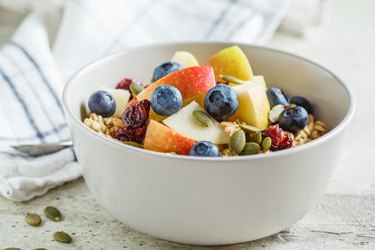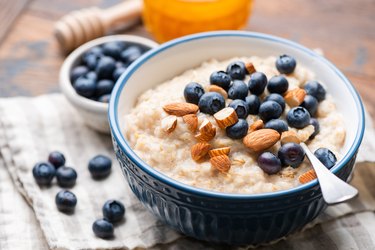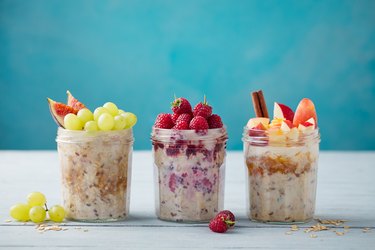
Avocado toast is making a splash in the breakfast scene, but that doesn't mean we should forget about our tried-and-true a.m. classic, oatmeal.
While most folks eat their oatmeal cooked and combined with sweet toppings, we can't blame you for wondering whether it's safe to eat the breakfast staple raw. (Hey, that saves you some time, right?)
Video of the Day
Video of the Day
Here's the gist: Eating raw oats is generally safe — depending on the oats you choose.
What Are Raw Oats?
Raw oats aren't the same thing as uncooked oats. So even though overnight oats may be stove-free, they're not raw oats in the strictest definition of the word.
That's because the oats you buy in the grocery store (regardless of the type) have been processed in some way. Raw oats, on the other hand, are straight-from-the-field oats with the kernels, hulls and stalks of the oat plant still intact, according to the Oldways Whole Grains Council.
More processed varieties of oats (like rolled oats and instant oats) have been pre-steamed and heated to destroy potentially harmful pathogens, making them safe to eat raw, according to the University of Wisconsin-Madison.
Though technically not "raw," according to the Oldways Whole Grains Council definition, there are less processed varieties such as groats and steel-cut oats, which don't undergo a steaming process and could, therefore, carry risky germs. That said, most folks don't eat raw steel-cut oats anyway, but you could definitely top your yogurt with some uncooked rolled oats!
Health Benefits of Eating Oatmeal
Oatmeal isn't just delicious — there are also a number of health benefits associated with the whole grain:
1. It's Nutritious
A great source of carbohydrates, oats boast an array of nutrients and health benefits.
Unlike refined grains typically found in breakfast cereals, whole-grain oats contain all three parts of the grain: the bran, the endosperm and the germ. Each of these parts contains its own nutrients including the following, according to the Harvard T.H. Chan School of Public Health:
- Fiber
- Vitamin E
- B vitamins
- Antioxidants
2. It's Linked to a Reduced Risk for Disease
Whole-grain oats contain beta-glucan, a type of soluble fiber that's associated with a reduced risk of heart disease, according to the Harvard T.H. Chan School of Public Health.
Oats can also help manage diabetes, thanks to their fiber, and support good gut health.
3. It May Help You Lose Weight
Oats are also a great food for those looking to maintain or lose weight. The oats' beta-glucan fiber attracts water and increases the volume of food in the gut, which leaves you feeling full for longer.
Potential Downsides of Eating Raw Oats
On the flip side, eating raw oats may have some drawbacks, including:
1. They May Not Taste as Good
Uncooked oats may not be as tasty as their cooked counterparts. While this ultimately depends on your preferences, a prepared bowl of oatmeal may be more appetizing.
2. Cooking Increases Their Nutritional Value
You already know oats are good for you, but there's no real upside to eating oats raw. In fact, the cooking process may actually release nutrients that your body can't glean from uncooked oats by itself, according to Harvard Health Publishing.
Check out the nutrition content per 1 ounce of different types of oats in the table below, per the USDA.
Types of Oats
Which Types of Oats Are Healthiest?
Your local supermarket's cereal aisle is probably populated with endless brands and varieties of oats.
While most oats are similar nutritionally — regardless of how they're processed — less processed oats (such as groats and steel-cut oats) tend to be lower on the glycemic index, which means that they won't spike your blood sugar as much, per the Harvard T.H. Chan School of Public Health.
1. Oat Groats
Groats are among the healthiest varieties and are lower on the glycemic index than more processed oats.
While they aren't as easy to find in every grocery store, oat groats are whole oat kernels that have been cleaned and removed of their inedible hulls — consider them the edible version of what you'd find in an oat field!
2. Steel-Cut Oats
These are oat groats that have been cut into two or three pieces, according to Oldways Whole Grain Council. They're less processed than rolled or instant oats and have a lesser effect on your blood sugar.
Steel-cut oats are much easier to find at your local grocer than oat groats.
3. Rolled Oats
Also referred to as old-fashioned oats, these undergo more processing and have been steamed, rolled and flattened.
Tip
Quick or instant oats are a highly processed variety and are often sold with added sugar, fruit or flavoring, which aren't the best choices. Quick or instant oats are still nutritious — just try to choose brands without added sugars.
How to Eat Oats

While more processed oatmeal and rolled oats are generally safe to eat raw, cooking your oatmeal or making overnight oats is probably your best (and tastiest) option.
Soak or steam your oatmeal with hot water or your milk of choice and toss in some healthy fruit. Overnight oats are a quick, no-cook option that involves soaking your oats in liquid (whether it's milk or water) overnight.
The end result will be a delicious, pudding-like breakfast that's both portable and filling.
- Harvard School of Public Health: "Whole Grains"
- Harvard School of Public Health: "Oats"
- University of Wisconsin-Madison: "The Safety of Raw Oatmeal"
- Oldways Whole Grain Council: "Types of Oats"
- Kaiser Permanente: "Overnight Oats 4 Ways"
- My Food Data: "Millville - Rolled Oats"
- My Food Data: "Bob's Red Mill Natural Foods Inc. - Whole Grain Oat Groats"
- My Food Data: "Whole Foods Market Inc. - Steel-Cut Oats"
- USDA: "Oats, raw"

